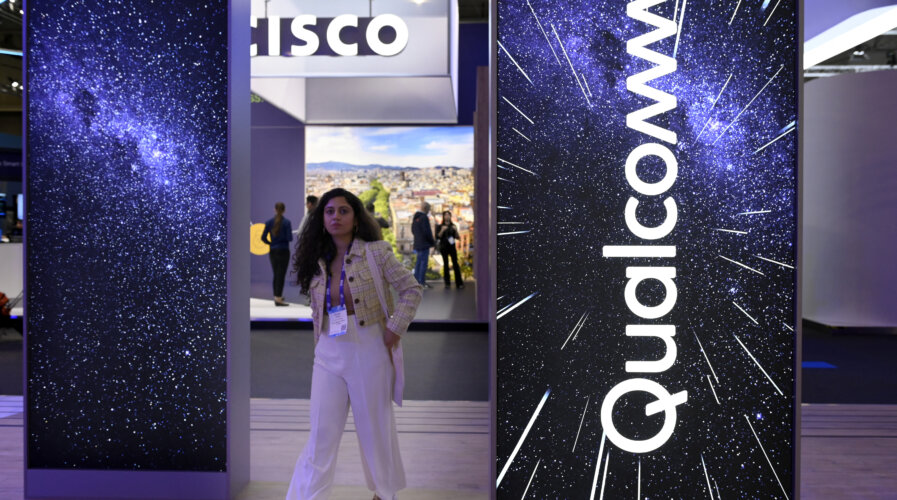
Qualcomm unveils Snapdragon XR2+ chip for VR and mixed reality headsets, challenging the forthcoming Vision Pro by Apple. (Photo by Josep LAGO / AFP)
Is Qualcomm gearing up to rival Apple in the VR headset arena?
- Qualcomm unveils Snapdragon XR2+ chip for VR and mixed reality headsets, challenging the forthcoming Vision Pro by Apple.
- The new chip, capable of running 12 or more high-definition cameras, will be used by Samsung and Google in their upcoming products.
- The upgraded Snapdragon XR2+ Gen 2 chip surpasses the 2023 XR2 Gen 2 used in the Meta Quest 3 with enhanced specifications.
When Apple, renowned for pushing the boundaries of consumer technology, unveiled its groundbreaking Vision Pro headset at last year’s Worldwide Developers Conference, success in the niche market suddenly seemed less elusive. Known for redefining struggling gadget categories, Apple’s entry into the space garnered widespread anticipation. Priced ambitiously at US$3,499, the long-awaited mixed-reality headset is set to debut early this year. But Apple may not have anticipated that it might face formidable competition sooner than later.
Last week, Qualcomm, a mobile processor powerhouse, introduced a new chip tailored for virtual and mixed-reality headsets. In short, the stage is set for a captivating showdown among tech giants in this evolving landscape. The Snapdragon XR2+ Gen 2 chipset, a single-chip architecture that will likely power most headsets, is anticipated to be released early this year. Moreover, the San Diego chipmaker announced that the latest component, capable of supporting 12 or more high-definition cameras, will be integrated into products currently in development by Samsung Electronics Co. and Alphabet Inc.’s Google, among others.
Other details surrounding Samsung and Google’s highly anticipated advanced mixed reality headset, poised to rival Apple’s Vision Pro, have been kept under wraps. To recall, Meta’s Quest 3 arrived last fall and was the first headset with Qualcomm’s first iteration of the XR chip, which boosted graphics, color passthrough camera quality, external camera support, and onboard AI feature possibilities.
Despite its somewhat perplexing jargon, the latest version of Qualcomm’s XR chips, the XR2+ Gen 2 chip, is strategically designed for an impending series of high-end headsets. It is positioned to directly contend with the Vision Pro by Apple in both features and pricing, signaling that there’d be more of these premium devices on the horizon.
How will headsets powered by Qualcomm differ from Vision Pro by Apple?

The features of Snapdragon XR2+ Gen 2. Source: Qualcomm
Enhancing the features of the previously introduced Snapdragon XR2 Gen 2, the plus variant showcases notable improvements, featuring a 15% boost in GPU frequency and a 20% increase in CPU frequency. Additionally, it supports an impressive 4.3K per eye resolution at 90fps and the capability for headsets to incorporate 12 or more cameras with on-device AI. This facilitates more accurate tracking of user movements and surrounding objects, elevating the quality of virtual and mixed-reality experiences to a more immersive and harmonious level.
Hugo Swart, vice president and general manager of XR at Qualcomm, also noted that the Snapdragon XR2+ Gen 2 unlocks 4.3K resolution, which will take “XR productivity and entertainment to the next level by bringing spectacularly clear visuals to use cases such as room-scale screens, life-size overlays, and virtual desktops.” In terms of efficiency gains, you can expect the same 50% improvement seen in the previous XR2 Gen 2 compared to the XR2 Gen 1 platform. In essence, there is no alteration on that front.

The Meta Quest 3 headset leverages groundbreaking mixed reality for immersive experiences, seamlessly integrating virtual elements into the physical world. Source: Meta
Quoting Qualcomm’s Said Bakadir, a senior director of product management, Bloomberg reported that the mobile processor giant is working with several partners in addition to Google and Samsung, and announcements from customers may come as soon as next week’s CES show with products available as early as this year, he said.
Will the VR/MR market finally take off to greater heights?
The Vision Pro by Apple is not merely a revolutionary leap forward; it stands poised as one of the most daring and ambitious launches in Apple’s storied history, teetering on the edge of risk and innovation. For Apple, the aim is to sustain the tech giant’s sales growth. In a familiar narrative reminiscent of the Mac, iPod, iPhone, and iPad launches, Apple aims to redefine an emerging industry.
But it is worth noting that the Vision Pro will be debuting with a premium price tag, entering a market that has yet to strike a chord with consumers. While the iPhone maker’s VR headset “is expected to bring lots of attention” to the technology, International Data Corp. (IDC) projected that Apple “will likely ship fewer than [200,000] units in the year.”
So far, the VR space has been dominated by Meta, which captured 55% of the market share in the third quarter of 2023, according to IDC, with the Quest 3 headset. IDC anticipates a robust recovery in 2024 for AR/VR headset shipments, labeling it a year of significant resurgence. The optimism is driven by introducing new products from Meta and Apple, especially after a challenging 2023 for the industry.
READ MORE
- Safer Automation: How Sophic and Firmus Succeeded in Malaysia with MDEC’s Support
- Privilege granted, not gained: Intelligent authorization for enhanced infrastructure productivity
- Low-Code produces the Proof-of-Possibilities
- New Wearables Enable Staff to Work Faster and Safer
- Experts weigh in on Oracle’s departure from adland


